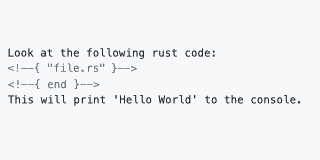4个版本 (2个破坏性更新)
| 0.3.1 | 2020年6月10日 |
|---|---|
| 0.3.0 | 2020年6月2日 |
| 0.2.0 | 2020年5月26日 |
| 0.1.0 | 2020年5月25日 |
#2503 in 解析器实现
每月38次下载
200KB
1.5K SLoC
md-inc - 将文件包含在Markdown文档中
概览

- 将外部文件包含到您的Markdown文档中 - 内联!
- 输入插入在命令块和结束块之间
- 覆盖之前的内容
- 转换包含的文件
- 将输入包裹在代码块或自定义文本中
- 筛选特定行
- 添加行号或其他行装饰
- 通过
.md-inc.toml文件轻松配置。- 指定1个或多个要转换的文件。
- 指定用于相对文件包含的基路径。
- 替换
<!--{和}-->标签 - 如果需要避免冲突或现有注释,则很有用。
示例
这是一个我们想在Markdown文档中包含的代码文件,file.rs
fn main() {
println!("Hello, World!");
}
该文件可以使用命令标签包含,巧妙地伪装成注释,以便它们不在实际文档中渲染
Look at the following rust code:
<!--{ "file.rs" | code: rust }-->
<!--{ end }-->
This will print 'Hello World' to the console.
运行md-inc后,文件将被转换成
Look at the following rust code:
<!--{ "file.rs" | code: rust }-->
```rust
fn main() {
println!("Hello, World!");
}
```
<!--{ end }-->
This will print 'Hello World' to the console.
注意:周围的```rust和```行是插入的,因为我们通过code: rust命令将输入管道传输。稍后将有更多关于这个话题的讨论!
安装
cargo install md-inc
运行
md-inc [FLAGS] [OPTIONS] [files]...
如果没有指定文件,则使用.md-inc.toml中的files字段。
配置
.md-inc.toml可以通过设置以下任何一项进行配置
open_tag:命令的起始标签
# <!--{ COMMAND }-->
# ^^^^^
open_tag = "<!--{"
close_tag:命令的结束标签
# <!--{ COMMAND }-->
# ^^^^
close_tag = "}-->"
end_command:要使用的结束命令的名称
# <!--{ COMMAND }-->
# <<FILE_CONTENTS>>
# <!--{ end }-->
# ^^^
end_command = "end"
base_dir:相对导入文件路径的基目录,相对于配置文件
# For the directory tree:
# ├╼ README.md
# ├╼ .md-inc.toml
# ╰╼ doc
# ├╼ file.txt
# ╰╼ other
# ╰╼ file2.txt
# If base_dir = "doc", then files can be named relative to doc
# <!--{ "file.txt" }-->
# ...
# <!--{ "other/file2.txt" }-->
base_dir = "doc"
files:要转换的文件列表,相对于配置文件
files = ["README.md", "doc/file.md"]
depend_dirs:包含 ".md-inc.toml" 的目录列表,在当前目录之前访问。
depend_dirs = ["doc/example1", "doc/example2"]
next_dirs:包含 ".md-inc.toml" 的目录列表,在当前目录之后访问。
next_dirs = ["doc/example1", "doc/example2"]
注意:"depend_dirs" 和 "next_dirs" 不会递归调用。
out_dir:生成文件的可选输出目录。如果定义了该值,则生成的文件将写入此目录而不是覆盖原始文件。
out_dir = "path/to/output"
命令
可以通过管道命令组合来操作包含的文件。
通用语法
包含 file.txt
<!--{ "file.txt }-->
<!--{ end }-->
在代码块中包含 file.txt
<!--{ "file.txt | code }-->
<!--{ end }-->
在带有 Python 语法高亮的代码块中包含 file.py
<!--{ "file.py" | code: python }-->
<!--{ end }-->
在带有 Python 语法高亮的代码块中仅包含 file.py 的第 4 到 10 行
<!--{ "file.py" | lines: 4 10 | code: python }-->
<!--{ end }-->
- 第一个值应该是文件名。
- 可以使用管道运算符 (
|) 连接命令。"file.txt" | code - 某些命令在冒号 (
:) 字符后可能需要空格分隔的参数。"file.txt | lines: 4 10" - 命令从左到右应用于包含的文件。
code: [language]
- 将文件包裹在代码块(三重反引号)中
language:用于语法高亮的语言。如果提供,则直接添加到顶部反引号之后。
没有语言
<!--{ "doc/file.txt" | code }-->
```
FILE_CONTENTS
```
<!--{ end }-->
有语言
<!--{ "doc/file.html" | code: html }-->
```html
FILE_CONTENTS
```
<!--{ end }-->
lines:first[last]
- 限制输入到给定的行范围
- (包括行,如果
first <= line <= last)
- (包括行,如果
first:要导入的第一行last:要导入的最后一行(基于1的索引)- 如果没有提供
last,则从first到输入的末尾包含所有行。
- 如果没有提供
给定文件,alphabet.txt
A
B
C
D
E
删除前导行
输入
<!--{ "alphabet.txt" | lines: 4 }-->
<!--{ end }-->
这保留第 4 行直到文件末尾。
输出
<!--{ "alphabet.txt" | lines: 4 }-->
D
E
<!--{ end }-->
删除尾随行
输入
<!--{ "alphabet.txt" | lines: 1 3 }-->
<!--{ end }-->
这仅保留第 1 到 3 行 输出:
<!--{ "alphabet.txt" | lines: 1 3 }-->
A
B
C
<!--{ end }-->
删除前导和尾随行
输入
<!--{ "alphabet.txt" | lines: 2 4 }-->
<!--{ end }-->
这仅保留第 2 到 4 行
输出
<!--{ "alphabet.txt" | lines: 2 4 }-->
B
C
D
<!--{ end }-->
line:list...
- 限制输入到给定的行号列表(基于1的索引)。
list...:要包含的行号列表
输入
<!--{ "alphabet.txt" | line: 3 2 1 }-->
<!--{ end }-->
输出
<!--{ "alphabet.txt" | line: 3 2 1 }-->
C
B
A
<!--{ end }-->
line-numbers: [separator] [width]
- 为每行添加行号
[separator]:行号和行其余部分之间使用的可选分隔符。- 如果没有提供,使用
:。
- 如果没有提供,使用
[width]:行号的可选宽度。- 如果没有提供,则使用最长行号的宽度。
使用默认参数
输入
<!--{ "full_alphabet.txt" | line-numbers | lines: 8 14 }-->
<!--{ end }-->
输出
<!--{ "full_alphabet.txt" | line-numbers | lines: 8 14 }-->
8: H
9: I
10: J
11: K
12: L
13: M
14: N
<!--{ end }-->
使用提供的参数
输入
<!--{ "alphabet.txt" | line-numbers: " " 4 }-->
<!--{ end }-->
输出
<!--{ "alphabet.txt" | line-numbers: " " 4 }-->
1 A
2 B
3 C
4 D
5 E
<!--{ end }-->
wrap: text 或 wrap: before after
- 在输入前后插入文本。
text:在输入前后插入的文本(不含换行符)before:在输入前插入的文本(不含换行符)。after:在输入后插入的文本(不含换行符)。
wrap-lines: text 或 wrap-lines: before after
- 在输入的每一行前后插入文本。
text:在输入的每一行前后插入的文本。before:在输入的每一行前插入的文本。after:在输入的每一行后插入的文本。
match:pattern[group_num]
- 从匹配模式的文件中插入文本。
pattern:正则表达式模式group_num:匹配group_num的捕获组将被插入。0的 group_num 是整个正则表达式模式
对于文件,hello_world.rs
// Main
fn main() {
println!("Hello, World!");
}
// Goodbye
fn goodbye() {
println!("Goodbye, World!");
}
使用 match 命令可以从 main() 函数中提取
输入
<!--{ "hello_world.rs" | match: "\n(fn main[\s\S]*?\n\})" 1 | code: rust }-->
<!--{ end }-->
输出
<!--{ "hello_world.rs" | match: "\n(fn main[\s\S]*?\n\})" 1 | code: rust }-->
```rust
fn main() {
println!("Hello, World!");
}
```
<!--{ end }-->
依赖关系
~5–7MB
~114K SLoC